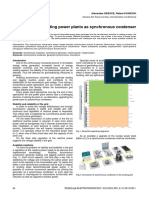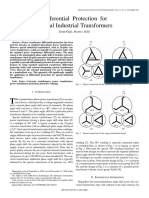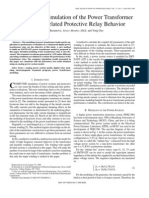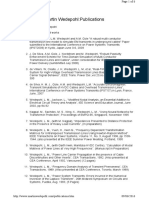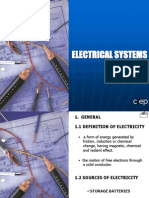Brushless Exciter
Brushless Exciter
Uploaded by
vgarudaCopyright:
Available Formats
Brushless Exciter
Brushless Exciter
Uploaded by
vgarudaCopyright
Available Formats
Share this document
Did you find this document useful?
Is this content inappropriate?
Copyright:
Available Formats
Brushless Exciter
Brushless Exciter
Uploaded by
vgarudaCopyright:
Available Formats
Brushless exciter model
S.M.L. Kabir
R. Shuttleworth
Indexing terms: Exciter, Power system behaviour, Simulation
Abstract: The IEEE model of a brushless exciter
can be found in many software packages for the
simulation of power system behaviour. Yet the
model is simplistic and does not represent the
exciter alternator accurately. This paper describes
the reasons for the inaccuracy of the IEEE repre-
sentation and proposes an alternative model.
Good agreement is obtained between results from
a micromachine test system and the alternative
model.
1 Int roduct i on
Generator exciters and automatic voltage regulator
play an important part in determining power system sta-
bility during transients. Nevertheless, general purpose
computer models describing their performance over a
wide range of operating conditions have not yet emerged.
This is because interactions between AVRs, exciters and
generators are complicated and not thoroughly under-
stood.
In 1968 an IEEE working party published a set of
excitation system models for use in large scale stability
studies. These models were devised in an attempt to
establish a unified approach to power system analysis. In
1981, the set was updated with the publication of a
second paper [l] reflecting changes in excitation tech-
nology and modelling methods. These models have
become widely used in industry, as was intended, to the
point where they are now considered a standard in the
specification and testing of excitation equipment as well
as in power system analysis.
Unfortunately the form of the IEEE models makes
them inappropriate for the universal role gradually being
forced upon them. This is evident from some of the con-
flicting results they yield in practice. These arise mainly
from misuse, since the models, designed for small signal
analysis are frequently used in the prediction of response
following a large disturbance. However, the limits of
applicability remain unknown as there has been no
precise guidance from the working party or any other
published source.
This indeterminate situation has led to unnecessary
conflicts between the users and suppliers of equipment.
The former are tending to apply IEEE models, often
embedded in standard software packages, to check on the
IEE, 1994
Paper 9704C (PlO), first received 1st October 1992 and in revised form
17th May 1993
S.M.L. Kabir is with B.U.E.T., Bangladesh
R. Shuttleworth is with the Electrical Engineering Laboratories, The
University, Manchester M13 9PL, United Kingdom
I E E Proc.-Gener. Transm. Distrib., Vol. 141, No. I , January 1994
specification of equipment supplied by the latter and to
predict its response to large scale disturbances. One of
the commonest excitation systems, the brushless exciter,
is particularly badly simulated by the IEEE model and
has caused confusion. For this reason the authors have
addressed the problem of brushless exciter modelling.
This paper describes a model which, whilst based on the
IEEE arrangement, takes better account of exciter behav-
iour and is able to predict responses more accurately.
2
In essence a brushless exciter is, as shown in Fig. 1, an
inside-out three-phase synchronous generator, the field
winding of which is mounted on the stator housing, the
The brushless exci t er - r ect i f i er system
generotor
exciter
f i el d
winding
a
f i el d
wl ndl ng generat or
t hree- phase
exciter t hree- phase
i w i n d 3 k - 1
rotating sect ion
Fi g. 1 Brushless exciter-generator
three-phase windings being attached to the rotor. The
three-phase output voltage is rectified by diodes mounted
on the rotating shaft and applied directly to the main
generator field winding. Thereby, sliprings and brushes
are eliminated, and maintenance costs reduced. I n most
cases the rectifier is a three-phase full wave bridge.
2.1 Effect of rectification on the exciter
It is generally known that, as a consequence of source
inductance, rectifying systems suffer from overlap. The
inductance in each phase of the supply opposes transfer
of current from rectifier to rectifier creating temporary
phase to phase short circuits, or overlaps, during the
cycle. The overall effect of these repetitive intervals of
overlap, each occurring for an angular duration U, is to
reduce the mean output voltage of the rectifying system.
For a three-phase bridge rectifier supplying an induct-
ive load, the rectification process can be divided into
The authors wish to thank Dr. R.D.M. Whitelaw
and Mr. B. Aranyos of CEC-Alsthom Turbine
Generators Ltd., and Prof. D.W. Auckland of
Manchester University, for their help and support.
61
three distinct modes, 1, 2, and 3, which occur in numeri-
cal sequence as load current increases from zero. A full
description of the phenomenon is given by Gayek [Z]
and Witzke et al. [3].
In brief, mode 1 is characterised by intervals of no
overlap, where two diodes conduct, interspaced with
intervals of overlap and the conduction of three diodes.
As the rectifying system output current increases, so does
the overlap angle U, until U reaches 60', which occurs at
the point of transition from mode 1 to mode 2. At this
transition point overlap becomes continuous and thus
three diodes are always conducting. In mode 2, U remains
constant at 60", and a delay angle, known as Y, appears
which retards the start of each overlap period. The angle
ct increases from 0" to 30" as the rectifying system moves
through mode 2 owing to increasing load current. When
ct equals 30", which signifies the transition from mode 2
to mode 3, an increase in load current will again increase
U, while ct remains fixed at 30". However as U increases, so
intervals of three-phase short circuits occur during the
overlap process. Increasing the load current causes both
U and the intervals of three-phase short circuit to
increase, until at the end of mode 3, a complete three-
phase short circuit is imposed upon the source, and U is
equal to 120". Thus for this level of load current and for
higher levels, the bridge becomes, for the load, a free-
wheeling path. This final short circuit condition will be
referred to as mode 4.
It follows that, as rectifier load current increases from
zero, so the power factor impressed upon the AC source
worsens, moving from almost unity at the beginning of
mode 1 to zero lagging at the end of mode 3 and
throughout mode 4.
3 The IEEE model
Fig. 2 shows the exciter and rectifier components of the
IEEE model. The voltage applied to the field winding of
the exciter is represented by V, on the left of the diagram
whereas E,, is the voltage applied to the main generator
field winding on the right of the model.
I t"
K E' 5 E 1 NMC l ml VE
:L<y-y?FD-
Fig. 2 I EEE brushless exciter model
The exciter per unit output voltage, V,, is larger than
E,,, owing to the previously described rectifier effect, by
an amount which is a function of I, , (the main generator
field current) and K , (the commutating reactance). The
rectifier voltage drop is modelled by the multiplier and
the two blocks which determine I , and FE, . K , and SE
represent the exciter's open circuit curve and K , is a
simple representation of armature reaction. The exciter's
field time constant and field current are represented by TE
and VFE.
The main problem with this model is in the represen-
tation of the exciter alternator by a simple fixed time con-
62
stant and fixed demagnetising term (TE and K,). As the
load current increases, so the rectifier system traverses
through the different modes of operation, and the power
factor seen by the alternator decreases [4]. Consequently
TE decreases nonlinearly, as load current increases, until
at the end of mode 3, a total three-phase short circuit
occurs. T, is then equal to T,, the short circuit value of
transient time constant, typically a fifth of the value of T,
applicable on no load. In a similar manner K, , the
demagnetising effect of load current, changes as load
power factor decreases, until at the extreme end of mode
3, demagnetisation is no longer caused by DC load
current, but by the flow of the exciter alternator's own
current into the bridge rectifier imposed short circuit. It
is these factors that detract from the model's accuracy
when used to predict responses.
A solution to these deficiencies can be realised by
replacing the single time constant exciter model with a
D-Q axis model. This at one stroke corrects the defects of
single time constant and fixed demagnetisation but intro-
duces the new problem of deriving I , and I, from recti-
fier action. Having decided to incorporate a D-Q axis
model it is worthwhile incorporating damper effects more
fully. since it is common practice nowadays to fit these to
exciters.
4 Al t er nat i ve models
The approach adopted was to develop an accurate
detailed computer model of a brushless exciter system
which represented every constituent part of the rectifier
and alternator system and was time stepped at intervals
of 1/200th of the period of exciter voltage.
This model was used as a benchmark against which a
simpler model, based on the IEEE simulation, but with
its defects removed, was tested. The second model can be
time stepped at much longer intervals, for instance half
the period of exciter voltage or more. Both models ignore
the effect of rectifier voltage drop, speed changes and
exciter saturation.
A dynamic model of a brushless exciter was also con-
structed, from which test results were obtained, and
against which results from the computer models could be
compared.
4.1 Complex digital model
This model uses Canay's D-Q axis representation to
simulate the exciter alternator. Canay's representation
[SI was chosen since i t has been shown [6,7] to give
excellent predictions of both field and stator current
waveforms. Fig. 3 is a block diagram of the model. The
phase voltage output fromthe Canay alternator model is
commutati on integer
Fig. 3 Complex digital model
I EE Proc.-Gener. Transm. Distrib., Vol. 141, No. I , January 1994
applied to a rectifier bridge simulation which performs
the necessary logic to determine the connections of the
phases to the DC load as follows.
At the end of every time step a commutation integer is
set with a value which indicates the state of the rectifier.
The values assigned to the integer indicate which phases,
if any, are being subjected to commutation, or, alterna-
tively, if a three-phase short circuit is occurring.
On the following time step this integer is used to
connect the load to the correct phases of the Canay
model. After calculating the new parameters a check is
made to see if the commutation integer has changed. If i t
has not, I , and I , are returned to the alternator model.
If, however, a change has occurred, then the com-
mutation integer, and hence load connection, is updated,
and the recalculated values of I , and I , are returned to
the alternator model. The program is slow in operation,
as it must, for accuracy, be time stepped at 0.1 ms inter-
vals for a 50Hz alternator. Typically it takes some
3 hours to simulate 5 seconds of exciter operation using
an IBM compatible PC. No doubt the model could be
improved in speed of operation, but this was not
attempted as its purpose was to give a benchmark for
development of the faster model to be described in the
next Section.
~
10
5 Simple di gi t al model
Fig. 4 is a block diagram of the model. As in the complex
model, a Canay representation of alternator behaviour is
used, but terms for rate of change of direct and quadra-
ture axis flux are omitted. Thus direct current terms in
the stator current cannot besimulated, but the model can
be time stepped with longer periods than the previous
model.
An assumption made is that rectifier operation,
although highly nonlinear, can be treated as a steady
state phenomenon since the repetitive line-to-line short
Of A1 and 81
.
l Dand 10 mode mode I FD
- .
81 U .O: calculation of
-
l oXQ
I
circuiting due to commutation occurs equally to all three
phases.
The Canay alternator simulation has applied to it, at
each time step, values of I , , I , and input voltage V,,
from which terminal voltages U, and U, are calculated.
Commutating reactance is assumed to be equal to sub-
transient reactance [4] and the phasor values of voltage
behind this, U, , and U, , , are thus determined as shown
in Fig. 5. The per unit alternator output voltage, V,,
follows. The simple rectifier simulation proposed by the
I EEE is used, with the inclusion of a fourth mode of
operation which accounts for freewheeling of generator
field currents through the bridge rectifier, as explained in
Section 2.
Fig. 5 Phasor diagram
I , and I , can be determined fromthe real and reactive
currents, AI and B1, taken by the rectifier, providing
these can be determined. Formulas for calculating A1
and B1 can be found in the literature [2, 8, 91 but only
for modes 1 and 2. Mode 3 has been neglected in the
literature with the exception of Ferguson et al. [4] who
provide a graphical solution for a machine of particular
subtransient reactance. I n order to obtain a mathemati-
Fig. 4 Simple digital model
I EE Proc-Gener. Transm. Distrib., Vol. 141, No. I , January 19Y4 63
cal representation, suitable for use in a computer, of real
and reactive currents in mode 3, it was necessary to
perform a Fourier analysis of the alternating current
taken by the rectifier. This analysis was based upon the
description of mode 3 operation given by Witzke et al.
[3]. The formulas derived for mode 3 are unlike the
equivalent formulas for modes 1 and 2 as they include the
terms V,/X, as a result of the repetitive three-phase short
circuits.
Having determined A1 and E1 for three modes of rec-
tifier operation, I , and I , can be found from the phasor
diagram of Fig. 5 as UD0, UQo and VE are known. In the
case of mode 4, the alternator supplies reactive current to
the short circuiting rectifier so that A1 =0 and E1 =
V,/X,. A complete list of the formulas used is given in
Appendix 1 1.1.
6 Test syst em
Obtaining test results from a brushless exciter is of course
difficult as it is an integral part of the main generator.
For this reason, two microalternators were used to simu-
late a brushless exciter and main generator, as shown in
Fig. 6. The machines were rated at 220 V, 3 kVA and
50 Hz, and were driven by DC motors.
I I
round rotor
I machine
h -
MOSFET rectiiier
sirnulotion
shadow
winding
f
Fig. 6 Diagram ojmicromuhine t est system
The first microalternator had a salient pole rotor with
wound direct and quadrature axis damper circuits and
was used to represent the brushless exciter alternator.
The second machine had a round rotor with wound
direct and quadrature axis damper circuits and was used
to simulate the field winding of the main generator. So as
to minimise the complexity of the physical model, the
damper circuits of the second microalternator were open-
circuited, thereby ensuring the field winding represented
a single time constant load. I t was thus possible at a later
stage to reconnect the damper circuits and simulate a
complete brushless exciter-generator system. This
allowed the impact of disturbances at the main generator
terminals on the exciter rectifier system to be invest-
igated.
Because the two microalternators had identical ratings
it was necessary to operate the salient pole machine with
a low field current to avoid over exciting the round rotor
machine. At this current level brush drop is significant
and so the graphite brushes of the salient pole micro-
alternator were replaced by low voltage drop copper
loaded brushes. Losses in the field brushes of the round
rotor machine were minimised by the same method.
Standard silicon diodes were not used in the bridge
rectifier as their voltage drop is significant. Instead rec-
64
tifying elements comprising two power MOSFETs in
bilateral configuration driven by an operational amplifier
clamp circuit were used. These introduced a low resist-
ance of 0.1 R which is about 2.5% of the load resistance.
It is usual for microalternator windings to be fitted
with time constant regulating equipment (TCRs) [lo, 1 I].
Although TCRs were available for the salient pole
machine it was decided not to use these as their band-
width of 100Hz, which is adequate for normal power
systemstudies, would cause undue attenuation of the rec-
tifier induced harmonic currents. However, it was neces-
sary to enhance the natural time constant of the round
rotor field circuit as this, being about looms, was
untypical of a large generator. A continuously acting
TCR was used to increase this time constant by a factor
of 50. The amplifier used had a gain of 50 and a band-
width of 2 kHz, which calculations showed was enough
bandwidth to ensure adequate time constant com-
pensation for harmonics. This was proven by tests at a
lower amplifier gain of 10 performed with 10 kHz and
2 kHz bandwidths which produced identical results,
validating the choice of 2 kHz.
7 Test resul ts
A step input of 1 p.u. excitation voltage was applied to
the field winding of the salient pole alternator and the
consequent variations in field and load current were
recorded. These results were plotted and the responses of
the two digital models, and the standard I EEE model,
compared with them.
The parameters used in the digital models were deter-
mined from a three-phase sudden short circuit test per-
formed on the salient pole machine at a current level
approximately equal to that used in the step test above.
The parameters are given in Appendix 11.2. A flux
linkage versus current plot for the field winding of the
round rotor machine, from zero to the appropriate
current level and back to zero, is shown in Fig. 7. For
increasing current, the curve has, approximately, a slope
current
Fig. 7 Flux linkage versus current plotfor the DC load
I EE Proc.-Gener. Transm. Distrib., Vol . 141, No. I , January 1994
equal to an inductance of 25. 6H. Fig. 8 compares the
responses of the two computer models with the step test
described. Despite the simplifications involved in the
simple model it follows closely the results of the complex
model.
/'
0 - ' . . . % , I 1 I I
0 0 5 10 15 2 0 2 5 3 0 3 5 4 0 4 5 50
time, s
Fig. 8
held uoltage
a field current of simple model
h field current ofcomplex model
< load current of complex model
d load current of simple model
Responses oJ rhe fwo computer models to a 1 p U step inpur of
Fig. 9 compares the responses of the simple digital
model and the microalternator test system. Good agree-
ment is obtained between field current displacements but
agreement between load currents is poorer, being in error
on the rising and falling edges. Nevertheless, peak load
current and the time of its occurrence are well predicted.
Fig. 10 shows the poorer agreement between the IEEE
model and the microalternator test system.
o 1 / , , , , , , , , , ,
0 0 5 1 0 1 5 2 0 2 5 3 0 3 5 4 0 4 5 5 0
time, s
Fig. 9
per unit step i nput ofjield t dt aye
o field current of simple model
b field current of test system
c load current of simple model
d load current of test system
Responses oJ-simple computer model and test system to a one
curves shown in Fig. 11. The mean slope of the curve
from A to B is approximately 40% less than the mean
slope from 0 to A. Thus the inductance presented by the
load during falling current is about 40% less than that
for rising current. If this change in load inductance for
decreasing load current is incorporated into the simple
digital model, excellent postpeak agreement results, as
shown in Fig. 12. The simple digital model has then a
slight error on the rising edge of load current due to the
varying load inductance in this zone. The complexity
involved in correcting this small error by accurate load
inductance modelling is not warranted.
1 4 -
1 2 -
;I 0-
2
z o e -
.-
$ 0 6 -
O b ' ' ' ' ' j ' ' ' '
4
0 0 5 10 1 5 2 0 2 5 3 0 3 5 4 0 4 5 5 0
time, s
Responses o f I EEE model and test sysfem to a I p U unit step Fig. 10
input offield coltage
(1 field current of IEEE model
b field current of test system
c load current of IEEE model
d load current of lest system
The difference between test and predicted results in
Fig. 9 was caused by the varying inductance of the gener-
ator field winding. Fig. 11 shows the flux linkage versus
load current plot for the actual step test. As load current
changes, the flux linkages follow the trajectory shown by
arrows, moving from the origin, 0, to point A at the
current peak and then falling from A to B, the final oper-
ating point, as current decreases. The inductance seen by
the rectifier at a particular current is the slope of the
I EE Proc.-Gener. Transm. Distrib., Vol. 141. No. I , January 1994
0 current
Fi g. 11 Flux linkage versus current plot for the step test
8 Discussion
From Fig. 8 it can beseen that the simple digital model,
despite its simplification produces results almost identical
to those of the complex model, yet it takes only 90s as
opposed to 3 h to run on the same '286 PC.
65
The importance of the work is in demonstrating the
error of using oversimplistic models. In the case of the
brushless exciter, the exciters field current is the only
signal reliable enough for use in the voltage control
system and thus an accurate model of exciter, rectifier
and generator behaviour is essential, if system response is
to be guaranteed.
oil/ , , , , , . , , , ,
/
0 0 5 10 1 5 2 0 2 5 3 0 3 5 4 0 4 5 50
t i me, s
Fig. 12
able load inductance to a I p.u. step input offield voltage
a fieldcurrent of simplemodel with variableloadinductance
b fieldcurrent of test system
c loadcurrent of simplemodel with variableloadinductance
d loadcurrent of test system
Responses of the test system and the simple model with vari-
Another important facet of this work is the exposure
of the hysteresis effect, which temporarily reduces the
main generators field inductance, producing a faster
response for decreasing field current. Yet the hysteresis is
hardly detectable on the microalternator open circuit
curve, showing that it occurs within the field leakage
inductance. It is probable that the effect will occur to
some degree in a large machine.
9 Conclusions
It can be concluded, because the simple and complex
digital models agree so well and because they have differ-
ent methods of simulating rectifier and load, that the
simple digital model is performing corectly.
Good agreement also exists between the simple digital
model and the microalternator model, thus proving that
the simple digital model is capable of accurately simulat-
ing large scale disturbances applied to the exciter field
windings. It is not yet known whether the model will ade-
quately simulate phenomena caused by disturbances at
the main generator terminals.
The error caused by the IEEE model in simulating
exciter field current is intolerable as this is a most
important feedback signal. The simple digital model
described here eliminates this error.
10 References
1 Excitation systemmodels for power systemstability studies: IEEE
CommitteeReport, IEEE, Trans., 1981, PAS-100, (2), pp. 494-509
2 GAYEK, H.W.: Behaviour of brushless aircraft generating systems,
IEEE Trans., 1963, AS-1, (2), pp. 594-622
3 WITZKE, R.L., KRESSER, J.V., and DILLARD, J .K.: Influenceof
a.c. reactance on voltage regulation of 6-phase rectifiers, AIEE
Trans., Pt. 1, 1953,72, pp. 244-253
4 FERGUSON, R.W., HERBST, H., and MILLER, R.W.: Analytical
studies of the brushless excitation system, AIEE Trans., Pt. III(B),
1960,78, pp. 1815-1821
66
5 CANAY, I.M.: Determination of model parameters of synchronous
6 KABIR. S.M.L.: Dieital modellineof a lareeturboalternator. PhD
machines, I EE Proc. B, 1983,130, (2), pp. 86-94
Thesis, University orManchester, 7989 -
7 AUCKLAND, D.W., KABIR, S.M.L., and SHUTTLEWORTH, R.:
Generator model for power systemstudies, IEE Proc. C, 1990, 137,
(6). pp. 383-390
8 GAYEK, H.W.: Transfer characteristics of brushless aircraft gener-
ator systems, IEEE Trans., 1964, AS-2, (2), pp. 913-928
9 CHRISTENSON, E.F., WILLIS, C.H., and HERSKIND, C.C.:
Analysis of rectifier circuits, AIEE Trans., 1944,63, pp. 1048-1058
10 AUCKLAND, D.W., and SHUTTLEWORTH, R.: Compensation
systems for a micromachine model, IEE Proc. C, 1981, 128, (1).
pp. 12-17
11 AUCKLAND, D.W., SHUTTLEWORTH, R., and TURKI, Y.A.A.:
Micromachinemodel for thesimulation of turbinegenerators, IEE
Proc. C, 1987,134, (4), pp. 265-271
11 Appendixes
11 . I Appendix
RG and LG are the resistance and inductance of the load.
All other parameters have their usual meaning.
Simple digital model.
Canay model :
0 =LMD P ~ D +(LMD +LE)P~F
+( R K D +d L M D + +LKD) ) r KD (1)
EF =LMDP~D +(RF +P@MD +LE +LFWF
+( LMD +LE)P~KD (2)
0 =LMQ PI, +(RKQ +~ L M Q +LKQ) ) ~KQ (3)
YD =(LMD +LAYD +LMD I F +LMD I KD (4)
y Q =( LMQ + +L MQI K Q (5)
U, =oYQ + R A I D (6)
U , = - - o Y D+ R , I p (7)
U, , =U, - 1,x; (8)
U,, =U , - I DX$ (9)
v, =( U; , +u;,)12 (10)
(11)
Calculation of voltage behind subtransient reactance
Determination of VE and I ,
IN =Xc I FD VE
Calculation of FE,
If I , <0.433 then FE, =1 - 0.581, and mode =1
If 0.433 <I N <0.75 then FE, =(0.75 - I;)/
If 0.75 <I, <1.0 then FE, =1.732(1 - I, )
(12)
and mode =2 (13)
and mode =3 (14)
(15)
If I , 1.0 then FE, =0 and mode =4
Load current calculation
Calculation of U and t( (see Reference 2)
x, =[ ( ( I D x;) +(IQ xi))/(Ii +I;)] (18)
IEE Proc.-Gener. Transm. Distrib., Vol. 141, No. I , January I994
If mode =1 then If mode =4, then
- vE
A1 =OandBl =-
X;
Calculation of I , and I ,
I D =-(A1 U, , +B1 UQ,)/VE
I , =-(A1 U, , - B1 U,,)/VE
andcx=O (19)
Ifmode =2 then U =-and n a =tan-'[-] 9ZmXc (20)
3 ~ E F , J( 3)
If mode =3 then
and a =II/6 (21)
Determination of real and reactive currents
If mode =1 or 2 then
A1=Jo [,,(cos a +cos ( U +a))
(22)
n
Jo I
B1= (23)
2rI FD (cos a - cos (U +a))
(sin (2U +2 ~ ) - sin 2a - 2u)
If mode =3, then
Al =* (si ntu+; )+l )++ 4 n x ,
x (1 +cos ( U +3))
- + sin ( U +3)
(24)
B1=&(sin n x c ( U +y ) + cos ( 2U +a> -; U )
(25)
1 1.2 Appendix
Basic parameters of the salient pole micromachine and
load in per unit
X, =0.113
RA =0.005
XF =0.384
RE =0.00651
X,, =0.4528
R,, =0.69
X,, =0.84
X,, =0.16
R,, =0.055
L, =1.6
X,, =1.32
XE =-0.10774
R, =0.25 (includes an approximate allowance for
rectifier resistance)
IEE Proc.-Gener. Transm. Distrib., Vol. 141, No. I , January 1994 61
You might also like
- The Technology of Instrument Transformers: Current and Voltage Measurement and Insulation SystemsFrom EverandThe Technology of Instrument Transformers: Current and Voltage Measurement and Insulation SystemsNo ratings yet
- A Transfer Function Approach To Harmonic Filter DesignDocument15 pagesA Transfer Function Approach To Harmonic Filter DesignvgarudaNo ratings yet
- Open Phase Conditions in Transformers - Analysis and Protection AlgorithmDocument14 pagesOpen Phase Conditions in Transformers - Analysis and Protection AlgorithmMaximo Gomez GuerreroNo ratings yet
- Power Quality Issues of Distorted and Weak DistribDocument20 pagesPower Quality Issues of Distorted and Weak Distribvasu1984No ratings yet
- A Transfer Function Approach To Harmonic Filter DesignDocument15 pagesA Transfer Function Approach To Harmonic Filter DesignvgarudaNo ratings yet
- High Voltage Engineering Lab Project Report: Sir. Irtza GillaniDocument10 pagesHigh Voltage Engineering Lab Project Report: Sir. Irtza GillaniMuhammad Zargham AliNo ratings yet
- Influence of Sympathetic Inrush On Voltage DipsDocument12 pagesInfluence of Sympathetic Inrush On Voltage Dipsbedabrat13No ratings yet
- On Modelling Iron Core NonlinearitiesDocument9 pagesOn Modelling Iron Core Nonlinearitiesjdjjarami100% (1)
- Pre-Insertion Resistor of Switching Shunt Capacitor Banks: C L C LDocument7 pagesPre-Insertion Resistor of Switching Shunt Capacitor Banks: C L C LbyjuvcNo ratings yet
- Usage of Existing Power Plants As Synchronous CondenserDocument3 pagesUsage of Existing Power Plants As Synchronous CondenserClubplaya HondaNo ratings yet
- Magnetically Controlled Shunt Reactors - A New Type of FACTS DeviceDocument3 pagesMagnetically Controlled Shunt Reactors - A New Type of FACTS Devicemjbriceno@gmail.comNo ratings yet
- In A of Of: Failure Transformer of LevelsDocument9 pagesIn A of Of: Failure Transformer of Levelseeng8124No ratings yet
- Auto Transformer Insulation Coordination StudyDocument6 pagesAuto Transformer Insulation Coordination StudyrajfabNo ratings yet
- 04302522Document6 pages04302522proteccionesNo ratings yet
- V.N PJM Design & Application of Insulation Coordination and Surge ProtectionDocument3 pagesV.N PJM Design & Application of Insulation Coordination and Surge Protectionbkalatus1No ratings yet
- Calculation of Current Division in Parallel Single-Conductor - Petty, K.A.Document9 pagesCalculation of Current Division in Parallel Single-Conductor - Petty, K.A.eero.ylistaloNo ratings yet
- Paper KimbarkDocument6 pagesPaper KimbarkRamiro VasquezNo ratings yet
- Transient Recovery Voltage AnalysisDocument18 pagesTransient Recovery Voltage AnalysisJosNo ratings yet
- Harmonics Effect On Rectifier Current Imbalance Rev1Document6 pagesHarmonics Effect On Rectifier Current Imbalance Rev1Laurence MichaelNo ratings yet
- Power System Harmonics Causes and Effects PDFDocument8 pagesPower System Harmonics Causes and Effects PDFRamon DrakeNo ratings yet
- Multiple Re-Strikes Phenomenon When Using Vacuum CircuitDocument8 pagesMultiple Re-Strikes Phenomenon When Using Vacuum Circuitsrinivas80No ratings yet
- Calculation: Mutual of Circular Filaments DesiredDocument10 pagesCalculation: Mutual of Circular Filaments DesiredJelena Blagojevic-IgnjatovicNo ratings yet
- Open Core Power Voltage TransformerDocument17 pagesOpen Core Power Voltage TransformergebzoriNo ratings yet
- S2-6-Calculating Circulating Currents in Clamping Strucure and Preventing Gassing Problem - Manan Pandya-Siemens - Rev1Document3 pagesS2-6-Calculating Circulating Currents in Clamping Strucure and Preventing Gassing Problem - Manan Pandya-Siemens - Rev1MallikarjunNo ratings yet
- Tr. ConnectionsDocument34 pagesTr. ConnectionsAnonymous ufMAGXcskMNo ratings yet
- Analyzing and Applying Current TransformersDocument26 pagesAnalyzing and Applying Current Transformersarijit444100% (1)
- Analysis of Active Power Flow Control With Phase Shifting Transformer in AC Transmission LineDocument7 pagesAnalysis of Active Power Flow Control With Phase Shifting Transformer in AC Transmission LineEditor IJTSRDNo ratings yet
- Transformer Magnetizing Inrush Currents: For Most Transformers, It Is A Good Approximation ToDocument1 pageTransformer Magnetizing Inrush Currents: For Most Transformers, It Is A Good Approximation ToZnevba QuintanoNo ratings yet
- Harmonic Filtering - Electrical Installation GuideDocument4 pagesHarmonic Filtering - Electrical Installation GuidedhruvNo ratings yet
- Ferroresonance VT Gis v002Document4 pagesFerroresonance VT Gis v002qais652002No ratings yet
- Magnetically Controlled Shunt ReactorsDocument34 pagesMagnetically Controlled Shunt ReactorsnicomanfrediNo ratings yet
- Get in Step With SynchronizationDocument7 pagesGet in Step With SynchronizationCarlynMNo ratings yet
- Class07 Using Transmission LinesDocument24 pagesClass07 Using Transmission LinesVikram Raj SinghNo ratings yet
- Protection of Rotating AC Equipment Against Travelling WavesDocument7 pagesProtection of Rotating AC Equipment Against Travelling WavespwmvsiNo ratings yet
- Ferroresonance in Power SystemsDocument9 pagesFerroresonance in Power Systems_FlyMan_No ratings yet
- Comeelini Et Al. A Computer Program For Determining Electrical Resistance and Reactance of Any Transmission LineDocument7 pagesComeelini Et Al. A Computer Program For Determining Electrical Resistance and Reactance of Any Transmission LineMarcos EmmanuelNo ratings yet
- Rule BookDocument25 pagesRule BookTu ParceroNo ratings yet
- Cable With Standing CurvesDocument63 pagesCable With Standing CurvesRatheesh R NairNo ratings yet
- Temporary Overvoltages Following Transformer EnergizingDocument3 pagesTemporary Overvoltages Following Transformer EnergizingLuiz_F_A_ViannaNo ratings yet
- A Design Guide For HV Transformer Connection SelectionsDocument6 pagesA Design Guide For HV Transformer Connection SelectionsShiv ChauhanNo ratings yet
- Examples Ferroresonance in High Voltage Power System: N. Jacobson, Membec IEEEDocument7 pagesExamples Ferroresonance in High Voltage Power System: N. Jacobson, Membec IEEE_FlyMan_No ratings yet
- Power in Non Sinusoidal SituationsDocument28 pagesPower in Non Sinusoidal Situationsgokul_iyer2001No ratings yet
- IEEE-Point-on-Wave Capacitor Switching and Adjustable Speed DrivesDocument6 pagesIEEE-Point-on-Wave Capacitor Switching and Adjustable Speed DrivesGustavo AguayoNo ratings yet
- Available Fault Current Selective Coordination SpreadsheetDocument20 pagesAvailable Fault Current Selective Coordination SpreadsheetOmer SyedNo ratings yet
- Inrush Current CalculationDocument4 pagesInrush Current CalculationJournalNX - a Multidisciplinary Peer Reviewed JournalNo ratings yet
- Importance of X-R RatiosDocument6 pagesImportance of X-R RatiosNayreth MezonesNo ratings yet
- VCB Transients Study.Document6 pagesVCB Transients Study.Shiju Kp.No ratings yet
- Power Transformer Application For Wind Plant Substations: IEEE PES Wind Plant Collector System Design Working GroupDocument6 pagesPower Transformer Application For Wind Plant Substations: IEEE PES Wind Plant Collector System Design Working GroupCésar Díaz LiberonaNo ratings yet
- Surge Arrester Buyers Guide EdDocument84 pagesSurge Arrester Buyers Guide EdJoel PalomaresNo ratings yet
- Delvi Fault Current Calculations and Nec RequirementsDocument24 pagesDelvi Fault Current Calculations and Nec Requirementskisan singhNo ratings yet
- Phenomena FerroresonanceDocument7 pagesPhenomena FerroresonanceFarekh HuzairNo ratings yet
- Contactors For Capacitor Switching: Application GuideDocument21 pagesContactors For Capacitor Switching: Application GuidezwerrNo ratings yet
- Ferroresonant Configurations in Power Systems: V. Valverde, G. Buigues, A. J. Mazón, I. Zamora, I. AlbizuDocument6 pagesFerroresonant Configurations in Power Systems: V. Valverde, G. Buigues, A. J. Mazón, I. Zamora, I. AlbizuMehdi_Mashayekhi_172No ratings yet
- Ge Generator Short Circuit CharachteristicsDocument120 pagesGe Generator Short Circuit CharachteristicsEoin O'MahoneyNo ratings yet
- Current Transformer Sizing & Saturation Calculation With Transient Performance Analysis of CT Using ATP SoftwareDocument8 pagesCurrent Transformer Sizing & Saturation Calculation With Transient Performance Analysis of CT Using ATP SoftwareInvyteNo ratings yet
- Current Interruption Transients CalculationFrom EverandCurrent Interruption Transients CalculationRating: 4 out of 5 stars4/5 (1)
- Application of Flexible AC Transmission System Devices in Wind Energy Conversion SystemsFrom EverandApplication of Flexible AC Transmission System Devices in Wind Energy Conversion SystemsNo ratings yet
- Grid-Integrated and Standalone Photovoltaic Distributed Generation Systems: Analysis, Design, and ControlFrom EverandGrid-Integrated and Standalone Photovoltaic Distributed Generation Systems: Analysis, Design, and ControlNo ratings yet
- Performance Analysis of A Three-Phase Induction Motor Under Non-Sinusoidal and Unbalanced ConditionsDocument5 pagesPerformance Analysis of A Three-Phase Induction Motor Under Non-Sinusoidal and Unbalanced ConditionsRavinder RangaNo ratings yet
- 13IPST121Document7 pages13IPST121Anonymous 9VcxlFErfNo ratings yet
- Modelling of Power Transformer FaultsDocument7 pagesModelling of Power Transformer FaultselizabethloayzaNo ratings yet
- Iran EngDocument2 pagesIran EngHarry100% (1)
- BrushlessExciter With PMGDocument2 pagesBrushlessExciter With PMGvgaruda100% (1)
- KS1 Mathematics Paper 2 ReasoningDocument32 pagesKS1 Mathematics Paper 2 Reasoningvgaruda100% (1)
- Martin WedepohlDocument6 pagesMartin WedepohlvgarudaNo ratings yet
- AgamasDocument17 pagesAgamasvgaruda100% (1)
- Martin WedepohlDocument6 pagesMartin WedepohlvgarudaNo ratings yet
- AchAryarkaL VAzhi ThirunAmam EngDocument8 pagesAchAryarkaL VAzhi ThirunAmam EngvgarudaNo ratings yet
- Elspec 4400Document5 pagesElspec 4400vgarudaNo ratings yet
- Krishna Ashtakam EnglishDocument2 pagesKrishna Ashtakam EnglishvgarudaNo ratings yet
- Hough End Leisure Centre Swimming Pool Timetable: MondayDocument1 pageHough End Leisure Centre Swimming Pool Timetable: MondayvgarudaNo ratings yet
- G4K User Installation GuideDocument300 pagesG4K User Installation GuidevgarudaNo ratings yet
- VT Guard For FerroResonanceDocument10 pagesVT Guard For FerroResonancevgarudaNo ratings yet
- G4500 ElspecDocument5 pagesG4500 ElspecvgarudaNo ratings yet
- TIs Selección TI Medida ANSIcr-magnetics-pi-selecting-ansi-classDocument1 pageTIs Selección TI Medida ANSIcr-magnetics-pi-selecting-ansi-classjavigutipenaNo ratings yet
- Installation of NEPLAN V5.x DemoDocument2 pagesInstallation of NEPLAN V5.x DemovgarudaNo ratings yet
- Con 2018069Document81 pagesCon 2018069praveenniteenNo ratings yet
- What Is Voltage Stabilizer & How It Works? Types of StabilizersDocument15 pagesWhat Is Voltage Stabilizer & How It Works? Types of StabilizersCHakornNo ratings yet
- AS380 Machine On-Site DebuggingDocument5 pagesAS380 Machine On-Site DebuggingTroubleshooting100% (1)
- Power Quality Enhancement and Mitigation of Voltage Sag Using DPFCDocument7 pagesPower Quality Enhancement and Mitigation of Voltage Sag Using DPFCVijay KrishnaNo ratings yet
- Characteristic and Non-Characteristic Harmonics HaDocument14 pagesCharacteristic and Non-Characteristic Harmonics HacqxwfmyzvqykvtrgwzNo ratings yet
- EDS 08-0143 - Customer LV Supplies Above 100A PDFDocument29 pagesEDS 08-0143 - Customer LV Supplies Above 100A PDFRajendra Prasad ShuklaNo ratings yet
- Simeas T: Transducers For Power VariablesDocument43 pagesSimeas T: Transducers For Power VariablesAluminaLabNo ratings yet
- N3231, N3306, N3312, N3356, N3400, N3531, N3800: LenntechDocument14 pagesN3231, N3306, N3312, N3356, N3400, N3531, N3800: LenntechMarcsLeungNo ratings yet
- Connection Lead Sets 8951Document18 pagesConnection Lead Sets 8951theaarelyifyNo ratings yet
- Patrick, Dale R. - Fardo, Stephen W. - Rotating Electrical Machines and Power Systems-Fairmont Press, Inc. (1997)Document591 pagesPatrick, Dale R. - Fardo, Stephen W. - Rotating Electrical Machines and Power Systems-Fairmont Press, Inc. (1997)Sakthivel PNo ratings yet
- ABB - Product Portfolio For MV Outdoor and Underground Networks - A4 - ENGDocument6 pagesABB - Product Portfolio For MV Outdoor and Underground Networks - A4 - ENGMartínCárdenasOyarseNo ratings yet
- Pe 12Document31 pagesPe 12Santhosh Kumar JNo ratings yet
- REVO VMII Users ManualDocument34 pagesREVO VMII Users Manualhamza100% (1)
- Electrical Systems PDFDocument17 pagesElectrical Systems PDFJehan MohamadNo ratings yet
- DocumentationDocument18 pagesDocumentationlaysNo ratings yet
- System ModelingDocument64 pagesSystem ModelingShuvo ShahedNo ratings yet
- Installation Manual DWDocument4 pagesInstallation Manual DWEdilberto Alegato (EPPI)No ratings yet
- Eu1 Midterm NotesDocument60 pagesEu1 Midterm NotesBlessy Marie SottoNo ratings yet
- Socomec Price List NOV 2023 WebDocument28 pagesSocomec Price List NOV 2023 WebrameshNo ratings yet
- Healthcare Interpretation of IEE Guidance Note 7 (Chapter 10) and IEC 60364-7-710 ForDocument31 pagesHealthcare Interpretation of IEE Guidance Note 7 (Chapter 10) and IEC 60364-7-710 Forjlruizmat8679100% (1)
- LMH - Chapter4-Three Phase CircuitDocument83 pagesLMH - Chapter4-Three Phase CircuitNguyen Son N NguyenNo ratings yet
- PSA Mod3Document22 pagesPSA Mod3Aishwarya PKamatagiNo ratings yet
- Gossen Metrawatt Metraclip 87 User ManualDocument74 pagesGossen Metrawatt Metraclip 87 User ManualMiftahNo ratings yet
- 1 Electrical SystemsDocument102 pages1 Electrical SystemsCollenne Kaye-Lie Garcia Uy100% (2)
- ET ALL UNITS NOTEs R19 II-I ECEDocument167 pagesET ALL UNITS NOTEs R19 II-I ECEhodNo ratings yet
- Electrical Machines LabDocument15 pagesElectrical Machines LabMuhammad Ali Khan AwanNo ratings yet
- 00784KO-FGD-E-SLD-0091 - Electrical SLD - Rev-01Document2 pages00784KO-FGD-E-SLD-0091 - Electrical SLD - Rev-01Bikram RoyNo ratings yet
- Fuseology: Amp Rating and Interrupting RatingDocument1 pageFuseology: Amp Rating and Interrupting Ratingbiruk yifruNo ratings yet
- AC-DC & DC-DC Converters For DC Motor Drives PDFDocument8 pagesAC-DC & DC-DC Converters For DC Motor Drives PDFaswardiNo ratings yet








